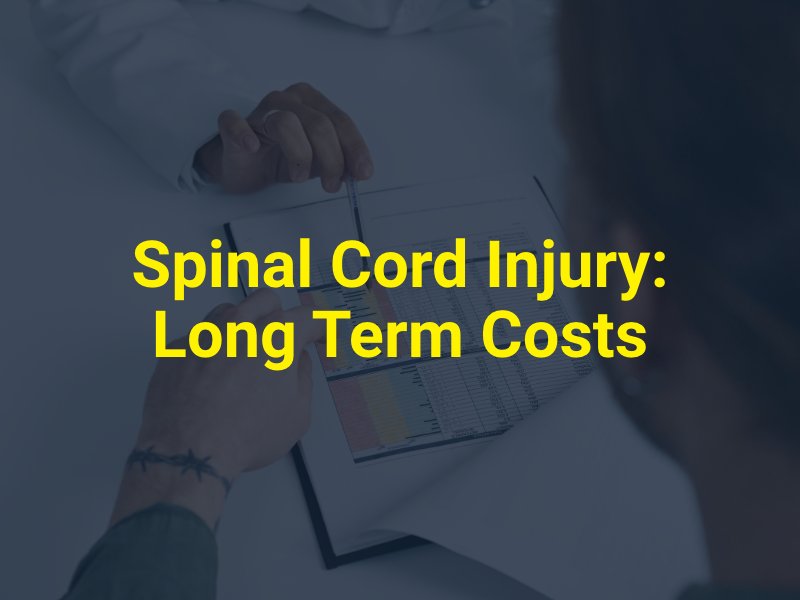Every year, 12,500 people suffer spinal cord injuries (SCI), mainly due to car accidents and falls. These injuries have long-term costs that go beyond just hospital bills, and it’s crucial to understand how these expenses manifest. Without understanding the full effect of your injury, you won’t be able to collect the compensation you’re truly entitled to.
Seeking advice from medical and legal professionals who are well-versed in spinal cord injuries is one of the best steps you can take. If your injury was caused by negligence, a Phoenix spinal cord injury attorney can help you recover compensation.
So, what are the true long-term costs of spinal cord injuries and what steps are taken to make this determination?

There are several factors that can impact the overall cost of living with a spinal cord injury. Some of these critical factors include:
The age of the patient at the time of injury plays a significant role in determining the lifetime expenses associated with a spinal cord injury. Typically, younger patients face higher lifetime costs as they require continuous care and support for a longer period.
The patient’s prognosis for recovery also greatly affects the costs involved in their treatment and care. A better prognosis might result in lower costs, as patients with strong recovery potential may require fewer specialized treatments or adaptive equipment.
The location of the spinal cord injury on the spine greatly impacts the necessary treatments, ongoing care, and adaptive equipment needs. Generally, higher spinal cord injuries result in greater impairments, necessitating more extensive support and care.
The majority of expenses linked to spinal cord injuries occur in the first year following the incident. Depending on the severity and location of the injury, first-year expenses can range from $350,000 up to almost 1 million dollars. The expenses remain significant in subsequent years, with projections spanning from $42,000 for incomplete motor function to $184,000 for high tetraplegia.
Some of the most common costs include the following:
An individual suffering from SCI is likely to face substantial medical expenses – the extent of which will be influenced by the injury’s severity and the ensuing complications. Some common areas of expenditure include:
The immediate medical intervention after the injury, which may involve resuscitation, ventilation, or other life-saving measures.
The initial treatment required to address the injury, stabilize the spine, and mitigate the extent of the damage.
The long-term process of regaining function, mobility, and independence through physical therapy, occupational therapy, and other therapeutic interventions.
The ongoing support needed to address chronic health issues, such as pain management, bladder and bowel management, wound care, and more.
The prescription drugs necessary for addressing various complications and side effects of SCI, such as pain control, muscle spasticity, or blood pressure regulation.
Costs associated with medical treatments differ considerably based on the extent of an injury and required care. For instance, individuals with high tetraplegia (affecting all four limbs) may require more extensive – and expensive – interventions than those with incomplete motor function.
Unfortunately, medical expenses aren’t the only costs to consider. You will also need to take into account the following potential expenses:
Adapting to a spinal cord injury often necessitates making changes to your living environment. This may include home modifications such as entrance ramps, widened doorways, and bathroom adaptations. These construction projects can be expensive, and the costs aren’t always covered by insurance or government programs.
Additionally, you may require mobility or assistive equipment, such as wheelchairs, lifts, or adaptive vehicle modifications. Maintenance costs related to spinal cord injury will become part of its long-term costs. Repair and replacement will add significantly to this total figure.
Spinal cord injuries often lead to mental health challenges, such as depression, anxiety, or post-traumatic stress disorder (PTSD). You may need ongoing psychological support, therapy, or medication, all of which have related costs that need consideration.
Additionally, many people with spinal cord injuries develop secondary or long-term health issues, such as bladder infections, pressure sores, or respiratory problems. You may require ongoing medical care and pharmaceutical assistance, which will contribute to your overall expenses.
Spinal cord injuries may require the need for specialized treatment and care. This may require you to travel long distances to reach healthcare providers, rehabilitation centers, or consultations with specialists. As a result, the costs of travel can quickly add up, from plane tickets and gas expenses to hotel stays and meals.
Hidden incidentals can also weigh heavily on your wallet. When spending extended periods in hospitals, seemingly minor costs such as vending machine snacks, parking, and tips can accumulate over time. Additionally, finding ways to keep entertained during long hospital stays and rehabilitation sessions may involve extra expenses for visits from friends and family or subscriptions to streaming services.
A spinal cord injury can significantly affect your ability to work, resulting in losses in both earnings and career advancement potential. This is especially problematic for higher earners, who may face steep reductions in income and lifestyle choices. As you navigate the challenges of recovering and adapting to new work limitations, it’s important to consider the effects on your long-term financial situation.
Spinal Cord Injury (SCI) impacts more than just your health – it affects every facet of life. Physical and emotional struggles often lead to stress in relationships, causing a spike in divorce rates among those affected.
Living with an SCI systematically changes one’s lifestyle requiring strength and resilience in the face of adversity. While it’s difficult, it’s also something that can be overcome. With consistent care and support from healthcare professionals as well as loved ones paired with ongoing therapy interventions for recovery, those affected can maintain hope amid their journey towards reclaiming their life.